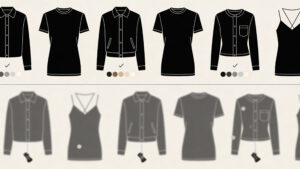Bringing an apparel collection to market can cost millions in design, samples, and late‑stage rush fees. What if you could eliminate up to 30% of that waste—before a single stitch is sewn?
With an Assortment Lifecycle Platform, cross‑functional teams share access to live line boards complete with real‑time product data and visuals—enabling them to make better, early-stage decisions. By shifting from reactive sample iteration to proactive portfolio curation, retail and apparel brands can eliminate wasted effort, cut costly prototyping rounds, and save hundreds of thousands (even millions) of dollars each year in development and supply‑chain costs.
The Hidden Costs of “Traditional” Sampling
Physical prototyping remains the industry’s default: sketch → tech‑pack → sample → review → repeat. But each cycle carries full “all‑in” costs:
- Design, merchandising & supply chain vendor hours: On average, a new SKU racks up 10–15 hours of internal work—design tweaks, spec updates, sourcing coordination—at a blended rate of $50–$100/hour.
- Sample creation: Estimated prototype costs run $150–$450 for materials, labor, and lab dips. Brands often build three or more iterations per style.
- Calendar drag: Late‑stage changes can add 2–4 weeks per cycle. Protracted calendars mean missed market windows and rushed logistics.
- Opportunity cost: While teams chase “fixes,” they aren’t ideating on new, higher‑potential concepts.
Consider a mid‑market brand developing 2,000 SKUs per year at $2,850 all‑in cost each. Three proto rounds per SKU multiplies spend to over $17M in dev budgets—before accounting for expedited freight, rush trims, or re‑work. It’s a costly game of trial and error.
Live Add/Drop Feedback Loops—and How They Work
Live line boards are real-time digital canvases where every proposed SKU lives as a high‑fidelity 3D render or accurate flat, accompanied by up-to-date product attributes. Cross‑functional teams—design, merchandising, sourcing, and leadership—can:
- View the entire assortment from a visual or “numbers” perspective
- Vote to add, drop, or keep individual concepts in real time.
- Comment directly on visuals, specs, and price points.
- Iterate virtually, without cutting fabric or calling in new samples.
Contrast this with the old-school approach: static PowerPoint decks emailed for feedback, siloed spreadsheets for cost breakdowns, endless review meetings to reconcile versions. Those processes are slow, error‑prone, and opaque—ensuring that dozens of weak concepts still make it into the sample room.
With a live, digital line board board and faster and frequent feedback loops, weak concepts are culled before a single proto. Teams spend anywhere from 30-50% less time on needless samples and tech‑pack updates—and calendars compress by 4–6 weeks on average.
Real‑World Impact at Vera Bradley: VibeIQ Case Study Highlights
Immediately after deploying VibeIQ, the team at Vera Bradley leveraged live line boards to visualize their entire assortment in one place for the first time. After “slicing and dicing” by colorway, the team quickly saw the appearance of one particular pattern across several categories. As a result, the team easily identified 20% over‑assortment and eliminated those styles before any sampling, realizing the following value:
- $$$ saved in sample spend
- Hundreds of designer and merch hours freed for high‑potential prints
- Faster alignment between design and merchandising, enabling more creative risk‑taking
How Retail Brands Can Prototype Smarter
The “how to” is simple in concept, but can be challenging to operationalize for brands with hundreds if not thousands of products and multiple seasons running at a time. At a high-level, teams should try to map and execute on the following:
- Map your current process. Document every decision gate and sample round. Note stakeholders involved and calendar timelines.
- Launch a live line board. Centralize all new‑season concepts with images, 2D and 3D visuals, and spec data. Give access to design, merch, sourcing, and executive teams.
- Run rapid add/drop/keep sessions. Schedule short, focused workshops where teams vote on each SKU. Remove low‑potential items virtually—no fabric cut, no sample sewn.
- Measure attrition & savings. Track the percentage of SKUs dropped pre‑proto. Multiply by your all‑in dev cost per SKU (e.g., $2,850) to quantify annual savings. Also log hours saved from reduced reviews and meetings.
However, to achieve scale and maximize the potential development and supply chain cost savings requires continuous optimization and ultimately free resources to help fuel more innovation. This is where an Assortment Lifecycle Platform like VibeIQ comes into play.
Prototype smarter. Cut costs. Accelerate success.
By embracing live line boards and earlier, faster and more frequent cross‑functional feedback loops, brands routinely achieve 20–30% reduction in development spend—transforming hundreds of thousands in wasted prototyping and labor into strategic runway for new ideas.
If you’re ready to make your next season leaner, faster, and more profitable, see how VibeIQ’s Assortment Lifecycle Platform can bring more confident decision making to your go-to-market product workflow by scheduling a personalized demo today.



